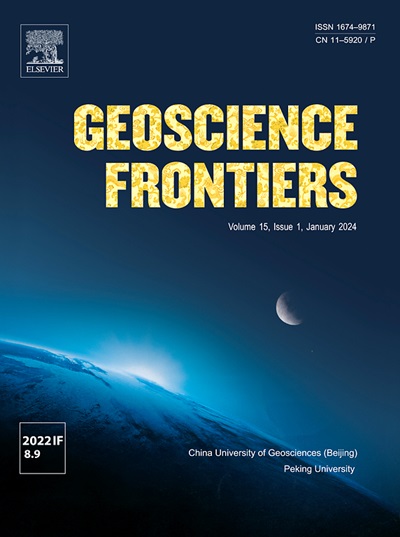地球外核液态 Fe-O 的状态方程和热力学性质
IF 8.9
1区 地球科学
Q1 GEOSCIENCES, MULTIDISCIPLINARY
引用次数: 0
摘要
状态方程(EoS)在外核组成的预测中起着至关重要的作用。本文通过第一性原理分子动力学模拟计算了外核条件(~ 136-330 GPa, 4000-6000 K)下液态铁氧合金(Fe-X wt.% O, X = 0,2.8, 6.1和9.9)的压力(P)-体积(V)-温度(T)数据。以P、T、V、O浓度为参数,建立了Fe-O液态合金的动力学方程。计算了液态Fe-O合金的密度(ρ)、热膨胀系数、等温和绝热体积模量以及声速(VP)等热力学性质。为了约束O含量,我们预测了沿地热的ρ-P和VP-P剖面,并与初步参考地球模型(PREM)的数据进行了比较。我们得出结论,绝热T剖面作为深度的函数显著影响O含量的预测。通过几个锚定的TICB, Fe-6.1 wt.% O的组成在可接受的误差范围内与PREM数据匹配。但严格来说,外核的分布可能是不均匀的。在这种情况下,我们声明外核中的O含量不能高于约6.1 wt.%。本文章由计算机程序翻译,如有差异,请以英文原文为准。


Equation of state and thermodynamic properties of liquid Fe-O in the Earth’s outer core
Equation of state (EoS) plays a crucial role in the prediction of the composition of the outer core. Here, we calculated pressure (P)-volume (V)-temperature (T) data of liquid iron-oxygen alloys (Fe-X wt.% O, X = 0, 2.8, 6.1, and 9.9) under the outer core conditions (∼136–330 GPa, 4000–6000 K) by first-principles molecular dynamics simulations. We established an EoS for liquid Fe-O alloys with parameters including P, T, V, and O concentrations. Consequently, thermodynamic properties of liquid Fe-O alloys such as density (ρ), thermal expansion coefficient, isothermal and adiabatic bulk modulus, and sound velocity (VP) are calculated. To constrain the O content, we predicted the ρ-P and VP-P profiles along the geotherm and compared them with data from the Preliminary Reference Earth Model (PREM). We conclude that the adiabatic T profile as a function of depth affects the prediction of O content dramatically. With several anchored TICB, the composition of Fe-6.1 wt.% O matches the PREM data with an acceptable range of error. But strictly speaking, the distribution in the outer core is probably uneven. In such case, we state that the O content in the outer core cannot be higher than approximately 6.1 wt.%.
求助全文
通过发布文献求助,成功后即可免费获取论文全文。
去求助
来源期刊

Geoscience frontiers
Earth and Planetary Sciences-General Earth and Planetary Sciences
CiteScore
17.80
自引率
3.40%
发文量
147
审稿时长
35 days
期刊介绍:
Geoscience Frontiers (GSF) is the Journal of China University of Geosciences (Beijing) and Peking University. It publishes peer-reviewed research articles and reviews in interdisciplinary fields of Earth and Planetary Sciences. GSF covers various research areas including petrology and geochemistry, lithospheric architecture and mantle dynamics, global tectonics, economic geology and fuel exploration, geophysics, stratigraphy and paleontology, environmental and engineering geology, astrogeology, and the nexus of resources-energy-emissions-climate under Sustainable Development Goals. The journal aims to bridge innovative, provocative, and challenging concepts and models in these fields, providing insights on correlations and evolution.
 求助内容:
求助内容: 应助结果提醒方式:
应助结果提醒方式:


